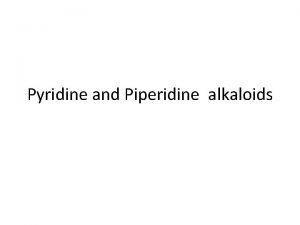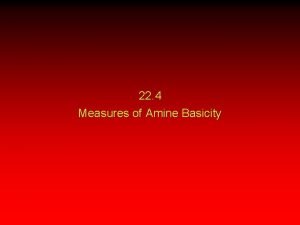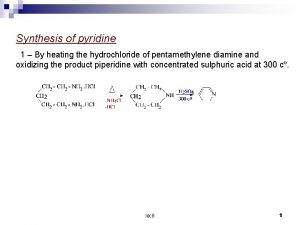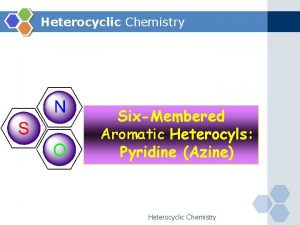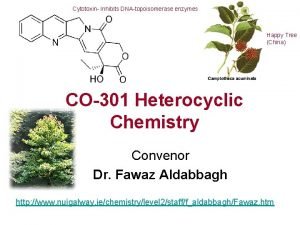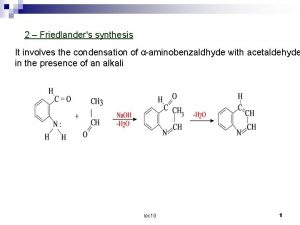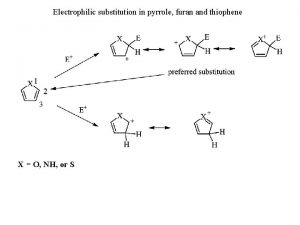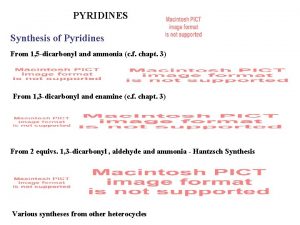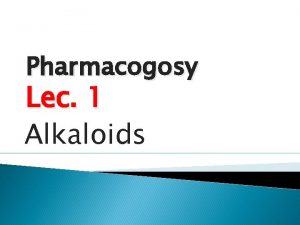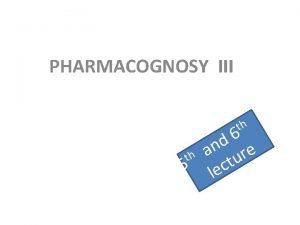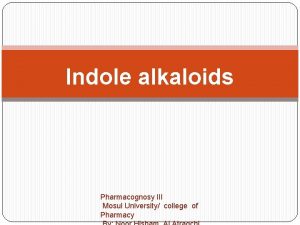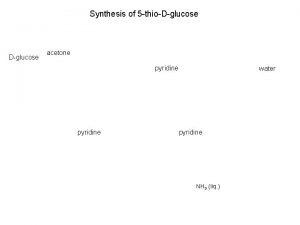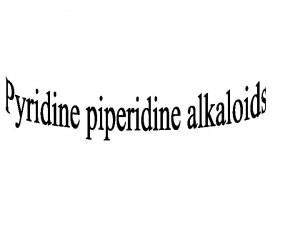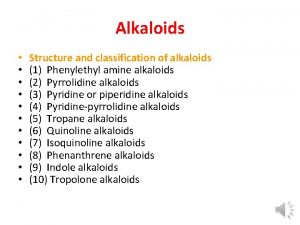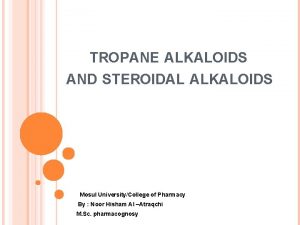Pyridine and Piperidine alkaloids Pyridine and Piperidine alkaloids











- Slides: 11

Pyridine and Piperidine alkaloids

Pyridine and Piperidine alkaloids • Pyridine, also called azabenzene and azine, • is a heterocyclic aromatic tertiary amine characterized by a sixmembered ring structure composed of five carbon atoms and nitrogen which replace one carbon–hydrogen unit in the benzene ring (C 5 H 5 N). • Piperidine, hexa-hydropyridine, is a family of heterocyclic organic compound derived from pyridine through hydrogenation.

Nicotine • The most widely studied member of the pyridine class is nicotine, the stimulant alkaloidal component of tobacco (Nicotiana tabacum, Solanaceae) • nicotine is responsible for the addictive nature of cigarettes and other tobacco preparations. • The compound has a pyrrole ring attached to the pyridine ring.

• It is isolated from of dried leaves of Nicotiana tobaccum, belonging to family Solanaceae. • The most important constituent is the alkaloids nicotine, nicotianin, nicotinine, nicoteline. • After leaves are smoked the nicotine decomposes into pyridine, furfurol, collidine, hydrocyanic acid, carbon monoxide, etc. The poisonous effects of Tobacco smoke are due to these substances of decomposed nicotine

Uses: • pharmaceutically nicotine used in form of chewing-gum, nasal spray or patch, to help smokers who want to give up smoking but who experience great difficulty in so doing because of their nicotine dependence.

Lobelia or Indian tobacco: Dried leaves and tops of lobelia inflata (F. lobeliaceae ) The drug contains 14 alkaloids of which lobeline is the major and most important. Actions : Similar but weaker than the pharmacologic effects of nicotine.

Lobelia inflata – Constituents Contains Pepperdine Alkaloids Most important • Lobeline Also contains: § Lobelidine § Lobelanine § Isolobelanine Lobelia inflata – uses 1. 2. 3. 4. Respiratory stimulant Asthma Chronic bronchitis Anti-smoking preparations Caution: Toxic doses the herb has a paralytic effect.

Imidazole alkaloids • Imidazole is a heterocyclic aromatic organic compound. • The most important pharmaceutical examples of this group are the Pilocarpus alkaloids, pilocarpine finding use as an ophthalmic cholinergic drug.

Jaborandi leaf and pilocarpine • The name 'jaborandi' is now applied to the leaflets of various species of Pilocarpus (Rutaceae), a genus of trees and shrubs well represented in South America and found to a lesser extent in the West Indies and Central America.

Constituents of jaborandi Jaborandi leaves contain about 0. 7 -0. 8% of alkaloids, include: • pilocarpine, • isopilocarpine. • pilosine and • isopilosine and • about 0. 5% of volatile oil. the • Isopilocarpine occurs in small quantity in the leaf but more is formed during the extraction process.

Uses • Pilocarpine directly stimulates the muscarinic receptors in the eye, causing constriction of the pupil and contraction of cilliary muscle. • Salts of pilocarpine (e. g. Pilocarpine Hydrochloride and Nitrate BP) are used in ophthalmic practice, as they cause contraction of the pupil of the eye, their action being antagonistic to that of atropine. • Both pilocarpin HCl and pilocarpine nitrate are cholinergic, used in in treatment of glaucoma. • It induces also free salivation and excites most gland secretions.
 Pyridine piperidine alkaloids
Pyridine piperidine alkaloids Basicity of arylamines
Basicity of arylamines Pyridine + hcl reaction
Pyridine + hcl reaction Chemical properties of pyridine
Chemical properties of pyridine Hydrolysis of furan
Hydrolysis of furan Friedlander synthesis
Friedlander synthesis Nucleophilic substitution reaction of pyrrole
Nucleophilic substitution reaction of pyrrole Pyridine synthesis from 1 5 dicarbonyl
Pyridine synthesis from 1 5 dicarbonyl Alkaloids definition pharmacognosy
Alkaloids definition pharmacognosy Pharmacognosy alkaloids
Pharmacognosy alkaloids Serpentiana
Serpentiana Lysergic acid hydroxyethylamide
Lysergic acid hydroxyethylamide
